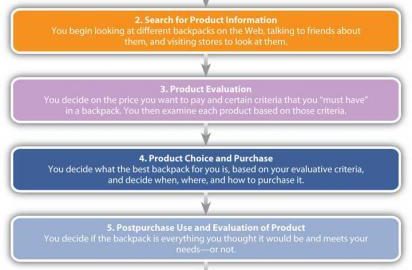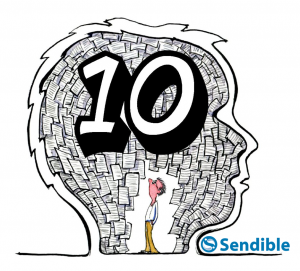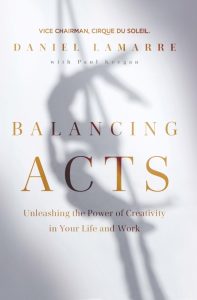Ever wonder about the process of customer decision-making?
Or, why you should care?
In today’s post, we’ll discuss the psychology of customer decision-making and how knowing how to use it can dramatically improve market performance.
So, let’s dive in, shall we?
The psychology of customer decision-making

Image courtesy of WebBooks.com
Here’s what the classic customer decision-making process looks like:
Now, let’s break down the steps. In the next section, we’ll talk about how to adjust your marketing for each aspect of the customer decision-making process.
1. Need recognition
Here we talk about a gap between where you are and where you’d like to be.
Let’s say you’re hungry. Most people don’t like being hungry, so you’d rather be full, right?
Notice, at this point, you don’t know how you’ll satisfy your need, just that you have one.
2. Information search
Now, you need information to help guide your decision. In the bad old days, that meant going to the store and talking to a salesperson or buying Consumer Reports or picking up some brochures. Anything that would give you more information about available products.
Today, we do most of our information search online, some of it very casually, as opposed to using a very structured approach.
We’re also likely to use internal information sources, those inside our own heads, for products we are familiar with.
Now, we’re starting to narrow down the options.
3. Product evaluation
Once we have information, we begin to evaluate our options.
Commonly, we put options into something called a consideration set of about 3-5 really good products. Alternatively, we may place options into an inept set, those we find unacceptable.
Sometimes product evaluation is very purposeful. For instance, we might construct tables of pluses and minuses to organize our product information. Other times, we use heuristics to help make product decisions.
4. Decision
At this step, we make our final selection and purchase the chosen product.
5. Post-purchase evaluation
How much did we like/ dislike the product — satisfaction is something you can only determine after buying the product. In some cases, you have to use the product for quite a while before making a determination of satisfaction. Plus, your satisfaction might change over time. For instance, a product that doesn’t hold up well might get lower evaluation later than it did initially.
As new products come out, you might evaluate your existing product lower because it doesn’t have the cool, new features of the newer products. Think about how you evaluate your mobile phone over time.
Cognitive dissonance is another post-purchase evaluation. Cognitive dissonance is an uncomfortable feeling that you made the wrong decision and is often not a reflection of the product purchased, but of opportunity costs, such as other things you might have done with the money spent.
Final thoughts on the psychology of consumer decision-making
- You don’t necessarily move through the decision-making process in a smooth, linear fashion. Sometimes you cycle, sometimes several times. Other times, you get stalled at some point and don’t move forward for a long time, sometimes never.
- Consumers vary significantly in how they make decisions. Some do it quickly, others take a long time and lots of information.
- Every consumer uses different heuristics in making decisions.
- Consumers spend a lot of time in post-purchase evaluation to improve their overall decision-making process.
- Outside factors have a significant impact on the customer decision-making process. And, that’s what we’ll talk about next.
How marketers can influence the customer decision-making process
Need recognition –
We have a saying in marketing, that marketing doesn’t create needs. But, consumers aren’t always aware of their needs and that’s where marketing comes in. For instance, late at night, you might be a little hungry, depending on when you ate dinner and what you ate. Pizza restaurants tend to advertise their food late at night and emphasize the deliciousness of it. Because they deliver, it’s the perfect option for late night snacking and a staple for college students everywhere.
Social media is an important part of need recognition. All those check-ins and shared vacation pics drive consumers to recognize needs to enjoy these places and experiences.
As marketers, we must stimulate awareness of needs, especially when it comes to comparing your state with that of your friends because it’s those comparisons that have the greatest impact. A certain activity, restaurant, shop, dress, or location might never occur to you without the help of your friends.
Friends even have a strong impact on major life decisions. When you see all the wedding pics in your newsfeed, you feel a strong pull to get married, renew your vows, or organize other wedding-like experiences. Baby pics have a big impact on the birth rate.
Information search
Your brain is the most common source for information about products. All those positive prior experiences guide your current decisions.
That’s where relationship marketing comes in. Prior to that, firms used to focus on selling a product to a customer. Now, firms should focus on creating positive experiences so current customers come back time after time. It’s 5X less expensive to retain and existing customer as it is to get a new one.
So, make your customers happy and you’ll improve market performance.
The second most common source for information search is from among your friends and acquaintances. You often gather this information without conscious effort — just from reading your social content — and store it away for when you’re facing a marketing decision.
So, do things that encourage customers to share positive experiences, make it easy for them to share, and you’ll improve market performance. We call this earned media.
The internet is a great source of information. So, put plenty of information online, both on your site and in your owned social networks, make it easy to navigate and you’ll improve market performance.
The last, and least effective, source of information is from brand advertising. That’s because we know they lie to us. Use paid media to build awareness, rather than motivate decision-making, and make paid media look as much like earned and owned media as possible.
So, paid advertising (paid media) should supplement, not replace earned and owned media.
Product evaluation
- Make it easy for consumers to evaluate your products by including information that might help in evaluations in a consistent and easy to find format.
- Make it easy for consumers to download that information.
- Use honest product comparisons to help with evaluations.
- Every consumer needs different information to make evaluations, so provide lots of information in different formats, but keep it easy to navigate.
- Consumers use heuristics so know which types of heuristics dominate decision-making by your customers with market research — more than just where they learned about your product. Use this information to construct heuristic-like information guides.
Decision
In marketing, we have little influence over the decision consumers make. We can attempt to influence their decision in earlier steps, but we have little control over the exact decision.
But, we do have a lot of control over making the purchase by reducing roadblocks to purchase. Here are some sources of roadblocks:
- No money — offering credit options or payment terms greatly improves market performance
- Payment options — I love PayPal, although I would like to see it made better. I love that I don’t have to share private information with websites I don’t know well. I love that I never have to go searching for my credit card before making a purchase. I love having all my purchases organized. Making it easy to pay, improves market performance
- Shipping – some folks need stuff NOW, some folks don’t like things delivered when they’re not home. If you’re a brick and mortar, think about product selection, sizes, colors to offer the most attractive assortment. When you’re running low on product, trade with other local stores. Don’t run out of stock. Offer lots of ways to get product, such as in-store pickup, and ensure product availability and you’ll improve market performance
- Returns – are a hassle. Consumers won’t reorder something until they get confirmation of the return and, if they return frequently, they may not buy. Several brick and mortar stores went out of business by making returns a big hassle.
Post-purchase evaluation
Try to delight customers — by giving them some extras — don’t just satisfy them.
A big part of customer satisfaction comes from keeping your promises both real and implied. Don’t promise things you can’t deliver and try to over-deliver. If you can’t keep your promise, make it up to the consumers.
For instance, I once ordered boots from LL Bean and they couldn’t deliver on the scheduled date. They sent me a replica of the boots as a keychain to let me know I hadn’t been forgotten. It was a nice touch.
Another time, I got a personal, handwritten note from the woman who packed my order when my local store didn’t have the product I wanted. That was so nice I kept the note — and continue shopping at that store frequently.
Remember birthdays, anniversaries, send thank-you notes …
Be a good corporate citizen by giving back to your community.
Eventually, folks will dispose of your produce. Help them do it responsibly because nothing is worse advertising than seeing your product become trash on roadsides and empty lots.
Some final thoughts on marketing based on customer decision-making
Just as consumers vary in how they move through the customer decision-making process, products impact that process.
For instance, impulse purchases might skip straight to decision, with minimal effort on the other steps. Some products use more emotional input into making the decision (commonly, these are convenience goods), while other products involve more cognitive steps (these are shopping products and specialty goods). Trying to make consumers think about toilet paper, commonly a convenience good, just doesn’t work well.
Use remarketing and set up email marketing so you don’t lose customers who got stalled in the decision-making process. The same goes for existing customers. Periodically remind them to buy from you again.
The customer decision-making process works within B2B markets, not just B2C.
This stuff is important, not just a little something extra. The difference in market performance is striking.
Business & Finance Articles on Business 2 Community(91)






